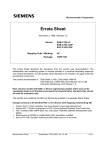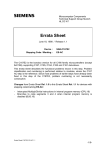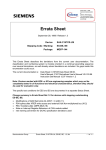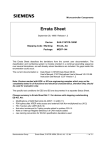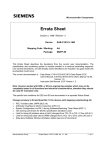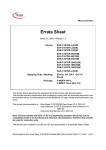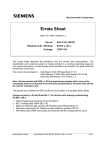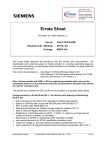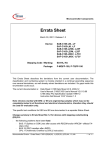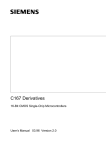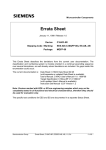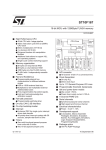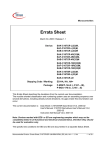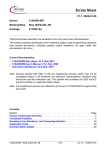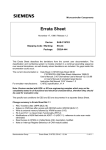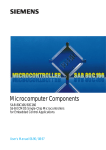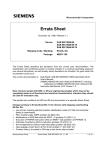Download Errata Sheet
Transcript
Microcontroller Components Errata Sheet May 29, 1998 / Release 1.0 Device: SAK-C167CR-LM SAK-C167CR-L25M Stepping Code / Marking: ES-CB, CB Package: MQFP-144 This Errata Sheet describes the deviations from the current user documentation. The classification and numbering system is module oriented in a continual ascending sequence over several derivatives, as well already solved deviations are included. So gaps inside this enumeration could occur. The current documentation is: Data Sheet: C167CR-4RM Data Sheet 07.97, C167SR/CR-L25M Data Sheet Addendum 1998-03 User’s Manual: C167 Derivatives User’s Manual V2.0 03.96 Instruction Set Manual 12.97 Version 1.2 Note: Devices marked with EES- or ES are engineering samples which may not be completely tested in all functional and electrical characteristics, therefore they should be used for evaluation only. The specific test conditions for EES and ES are documented in a separate Status Sheet. Change summary to Errata Sheet Rel.1.0 for devices with stepping code/marking ES-CB: • • • • • • • Modifications of ADM field while bit ADST = 0 (ADC.11) P0H spikes after XPER write access and external 8-bit Non-multiplexed bus (X12) Execution of PWRDN Instruction while pin NMI# = high (PWRDN.1) Bidirectional Hardware Reset (RST.3) Arithmetic Overflow by DIVLU instruction (CPU.17): workaround extended ADC Overload Current (ADCC.2) AC timing relaxations added Semiconductor Group Errata Sheet, C167CR-LM, ES-CB, CB, 1.1, Mh - 1 of 10 - Functional Problems: PWRDN.1: Execution of PWRDN Instruction while pin NMI# = high When instruction PWRDN is executed while pin NMI# is at a high level, power down mode should not be entered, and the PWRDN instruction should be ignored. However, under the conditions described below, the PWRDN instruction may not be ignored, and no further instructions are fetched from external memory, i.e. the CPU is in a quasi-idle state. This problem will only occur in the following situations: a) the instructions following the PWRDN instruction are located in external memory, and a multiplexed bus configuration with memory tristate waitstate (bit MTTCx = 0) is used, or b) the instruction preceeding the PWRDN instruction writes to external memory or an XPeripheral (XRAM, CAN), and the instructions following the PWRDN instruction are located in external memory. In this case, the problem will occur for any bus configuration. Note: the on-chip peripherals are still working correctly, in particular the Watchdog Timer will reset the device upon an overflow. Interrupts and PEC transfers, however, can not be processed. In case NMI# is asserted low while the device is in this quasi-idle state, power down mode is entered. Workaround: Ensure that no instruction which writes to external memory or an XPeripheral preceeds the PWRDN instruction, otherwise insert e.g. a NOP instruction in front of PWRDN. When a muliplexed bus with memory tristate waitstate is used, the PWRDN instruction should be executed out of internal RAM or XRAM. Semiconductor Group Errata Sheet, C167CR-LM, ES-CB, CB, 1.1, Mh - 2 of 10 - CPU.17: Arithmetic Overflow by DIVLU instruction For specific combinations of the values of the dividend (MDH,MDL) and divisor (Rn), the Overflow (V) flag in the PSW may not be set for unsigned divide operations, although an overflow occured. E.g.: MDH F0F0 MDL Rn MDH MDL 0F0Fh : F0F0h = FFFF FFFFh, but no Overflow indicated ! (result with 32-bit precision: 1 0000h) The same malfunction appears for the following combinations: n0n0 0n0n : n0n0 n00n 0nn0 : n00n n000 000n : n000 n0nn 0nnn : n0nn where n means any Hex Digit between 8 ... F i.e. all operand combinations where at least the most significat bit of the dividend (MDH) and the divisor (Rn) is set. In the cases where an overflow occurred after DIVLU, but the V flag is not set, the result in MDL is equal to FFFFh. Workaround: Skip execution of DIVLU in case an overflow would occur, and explicitly set V = 1. E.g.: CMP Rn, MDH JMPR cc_ugt, NoOverflow ; no overflow if Rn > MDH BSET V ; set V = 1 if overflow would occur JMPR cc_uc, NoDivide ; and skip DIVLU NoOverflow: DIVLU Rn NoDivide: ... ; next instruction, may evaluate correct V flag Note: - the KEIL C compiler, run time libraries and operating system RTX166 do not generate or use instruction sequences where the V flag in the PSW is tested after a DIVLU instruction. - with the TASKING C166 compiler, for the following intrinsic functions code is generated which uses the overflow flag for minimizing or maximizing the function result after a division with a DIVLU: _div_u32u16_u16() _div_s32u16_s16() _div_s32u16_s32() Consequently, an incorrect overflow flag (when clear instead of set) might affect the result of one of the above intrinsic functions but only in a situation where no correct result could be calculated anyway. These intrinsics first appeared in version 5.1r1 of the toolchain. Libraries: not affected Semiconductor Group Errata Sheet, C167CR-LM, ES-CB, CB, 1.1, Mh - 3 of 10 - ADC.11: Modifications of ADM field while bit ADST = 0 The A/D converter may unintentionally start one auto scan single conversion sequence when the following sequence of conditions is true: (1) the A/D converter has finished a fixed channel single or continuous conversion of an analog channel n > 0 (i.e. contents of ADCON.ADCH = n during this conversion) (2) the A/D converter is idle (i.e. ADBSY = 0) (3) then the conversion mode in the ADC Mode Selection field ADM is changed to Auto Scan Single (ADM = 10b) or Continuous (ADM = 11b) mode without setting bit ADST = 1 with the same instruction Under these conditions, the A/D converter will unintentionally start one auto scan single conversion sequence, beginning with channel n-1, down to channel number 0. In case the channel number ADCH has been changed before or with the same instruction which selected the auto scan mode, this channel number has no effect on the unintended auto scan sequence (i.e. it is not used in this auto scan sequence). Note: When a conversion is already in progress, and then the configuration in register ADCON is changed, - the new conversion mode in ADM is evaluated after the current conversion - the new channel number in ADCH and new status of bit ADST are evaluated after the current conversion when a conversion in fixed channel conversion mode is in progress, and after the current conversion sequence (i.e. after conversion of channel 0) when a conversion in an auto scan mode is in progress. In this case, it is a specified operational behaviour that channels n-1 .. 0 are converted when ADM is changed to an auto scan mode while a fixed channel conversion of channel n is in progress (see e.g. C167 User’s Manual, V2.0, p16-4) Workaround: When an auto scan conversion is to be performed, always start the A/D converter with the same instruction which sets the configuration in register ADCON. RST.3: Bidirectional Hardware Reset When the bidirectional reset feature is enabled (bit BDRSTEN/SYSCON.3 = 1), and a short hardware reset pulse (> 4 TCL) is applied to pin RSTIN#, the following problem may occur: Pin RSTIN# may not be driven low by the internal circuitry for the duration of the internal reset sequence if the falling edge of the hardware reset pulse occurred during the second cycle of a 2-cycle instruction (e.g. CALL, RETI, TRAP). As a consequence, the level at pin RSTIN# may be pulled up to a high level through the internal pullup in case the external reset source is no longer driving the pin low. Note: The internal reset sequence is always completed correctly. Software and Watchdog Timer reset are not affected by this problem. This problem will be fixed in the next step X9: Read Access to XPERs in Visible Mode The data of a read access to an XBUS-Peripheral (XRAM, CAN) in Visible Mode is not driven to the external bus. PORT0 is tristated during such read accesses. Semiconductor Group Errata Sheet, C167CR-LM, ES-CB, CB, 1.1, Mh - 4 of 10 - X12: P0H spikes after XPER write access and external 8-bit Non-multiplexed bus When an external 8-bit non-multiplexed bus mode is selected and P0H is used for general purpose I/O, and an internal (byte or word) write access to an XBUS peripheral (e.g. XRAM, CAN, or I²C module) is performed, and an external bus cycle is directly following the internal XBUS write cycle, then P0H is actively driven with the write data for approx. 7ns (spikes on P0H). The spikes also occur if P0H is configured as input. However, read operations from P0H are not affected and will always return the correct logical state. The spikes have the following position and shape in a typical application: spikes occur after the rising edge of CLKOUT which follows the rising edge of ALE for the external bus cycle P0H.x = low --> output low voltage rises to approx. 2.5V, spike width approx. 7ns (@ 0.2 Vcc) P0H.x = high --> output high voltage drops to approx. 2.0V, spike width approx. 7ns (@ 0.8 Vcc) Referring to a worst case simulation the maximum width of the spikes may be 15ns with full amplitude (Vcc/Vss). But this might not be seen on application level. Note that if any of the other bus modes is selected in addition to the 8-bit non-multiplexed mode, P0H can not be used for I/O per default. Workaround: - use a different port instead of P0H for I/O when (only) an external 8-bit non-multiplexed bus mode is selected or use a different bus type (e.g. 8-bit multiplexed, where P1H may be used for I/O instead of P0H) or the spikes on P0H may be filtered with an application specific RC element, or do not perform an external bus access directly after an XBUS write access: this may be achieved by an instruction sequence which is executed in internal ROM/Flash/OTP, or internal RAM, or internal XRAM e.g. ATOMIC #3 ; to prevent PEC transfers which may access external memory instruction which writes to XBUS peripheral NOP NOP Semiconductor Group Errata Sheet, C167CR-LM, ES-CB, CB, 1.1, Mh - 5 of 10 - Deviation from Electrical- and Timing Specification: The following table lists the deviations of the DC/AC characteristics from the specification in the C167CR-4RM Data Sheet 7.97 and C167SR/CR-L25M Data Sheet Addendum 1998-03 AC Characteristics: Vcc = 5 V ± 5 % fcpu = 24 MHz (L25M version only) CL = 50 pF Problem Parameter Symbol Limit Values Unit Test min. short name max. Condition DCVOL.1 Output low voltage (Port0/1/4, ALE, RD#, WR#, WRH#/BHE, CLKOUT, RSTOUT#) VOL - 0.45 V IOL = 2.0 mA instead of 2.4 mA DCAH.1 ALE active current IALEH 1000 instead of 500 - µA VOUT = 2.4 V DCRL.1 RD#/WR# active current IRWL -600 instead of -500 - µA VOUT = VOLmax DCP6L.1 Port 6 active current IP6L -600 instead of -500 - µA VOUT = VOLmax DCHYS.1 Input Hysteresis (Special Threshold) HYS 300 instead of 400 - mV - Semiconductor Group Errata Sheet, C167CR-LM, ES-CB, CB, 1.1, Mh - 6 of 10 - Parameter Symbol CPU Clock = 20 MHz Variable CPU Clock Unit 1/2TCL = 1 to 24 MHz min. max. min. max. 10+ta instead of 15+ta - TCL-15+ta instead of TCL-10+ta - ns WR#/WRH# low time t12 (with RW-delay) 38+tc instead of 40+tc - 2TCL-12+tc instead of 2TCL -10+tc - ns WR#/WRH# low time t13 (no RW-delay) 63+tc instead of 65+tc - 3TCL-12+tc instead of 3TCL -10+tc - ns Address hold after WRH# t28 -5+tf instead of 0+tf - -5+tf instead of 0+tf ns ALE falling edge to CS# t38 -7-ta 10-ta instead of 4-ta -7-ta instead of 4-ta 10-ta ns RDCS#/WRCS# low t48 time (with RW-delay) 38+tc instead of 40+tc - 2TCL-12+tc instead of 2TCL -10+tc - ns RDCS#/WRCS# low t49 time (with RW-delay) 63+tc instead of 65+tc - 3TCL-12+tc instead of 3TCL -10+tc - ns ALE high time t5 - Notes: 1) Pin READY# has an internal pullup (all C167xx derivatives). This will be documented in the next revision of the Data Sheet. 2) Timing t28: Parameter description and test changed from ’Address hold after RD#/WR#’ to ’Address hold after WR#’. It is guaranteed by design that read data are internally latched by the controller before the address changes. 3) During reset, the internal pullups on P6.[4:0] are active, independent whether the respective pins are used for CS# function after reset or not. Semiconductor Group Errata Sheet, C167CR-LM, ES-CB, CB, 1.1, Mh - 7 of 10 - ADCC.2: ADC Overload Current During exceptional conditions in the application system an overload current IOV can occur on the analog inputs of the A/D converter when VAIN > Vdd or VAIN < Vss. For this case, the following conditions are specified in the Data Sheet: IOVmax = | ±5 mA | The specified total unadjusted error TUEmax = | ±2 LSB | is only guaranteed if overload conditions occur on maximum 2 not selected analog input pins and the absolute sum of input overload currents on all analog input pins does not exceed 10 mA. Due to an internal problem, the specified TUE value is only met for a positive overload current IOV ≤ +5 mA (all currents flowing into the microcontroller are defined as positive and all currents flowing out of it are defined as negative). If the exceptional conditions in the application system cause a negative overload current, then the maximum TUE can be significantly exceeded (depending on value of IOV and RAIN of converted channel): when the negative overload current occurs on analog input channel ANn (n≠10), the accuracy of the neighbour channels ANn-1 and ANn+1 is affected when the negative overload current occurs on channel AN10, the accuracy of all other analog input channels is affected. Semiconductor Group Errata Sheet, C167CR-LM, ES-CB, CB, 1.1, Mh - 8 of 10 - History List (since device step BA) Functional Problems Functional Problem Short Description Fixed in step PWRDN.1 Execution of PWRDN Instruction while pin NMI# = high CPU.8 Jump instruction in EXTEND sequence CB CPU.9 PEC Transfers during instruction execution from Internal RAM CB CPU.11 Stack Underflow during Restart of Interrupted Multiply CB CPU.17 Arithmetic Overflow by DIVLU instruction RST.1 System Configuration via P0L.0 during Software/Watchdog Timer Reset RST.3 Bidirectional Hardware Reset ADC.8 CC31/ADC Interference CB ADC.10 Start of Standard Conversion at End of Injected Conversion CB ADC.11 Modifications of ADM field while bit ADST = 0 X9 Read Access to XPERs in Visible Mode X12 P0H spikes after XPER write access and external 8-bit Non-multiplexed bus CB AC/DC Deviations AC/DC Deviation Short Description Fixed in step see pages 6 .. 8 Semiconductor Group Errata Sheet, C167CR-LM, ES-CB, CB, 1.1, Mh - 9 of 10 - In addition to the description in the C167 Derivatives User’s Manual V2.0, the following feature enhancements have been implemented in the C167CR-LM CB-step and all higher steps: Incremental position sensor interface For each of the GPT1 timers T2, T3, T4 of the GPT1 unit, an additional operating mode has been implemented which allows to interface to incremental position sensors (A, B, Top0). This mode is selected for a timer Tx via TxM = 110b in register TxCON, x = (2, 3, 4). Optionally, the contents of T5 may be captured into register CAPREL upon an event on T3. This feature is selected via bit CT3 = 1 in register T5CON.10 Compatibility with previous versions: In previous versions (e.g. C167CR-LM BA-step), both of the settings (TxM = 110b, T5CON.10 = 1) were reserved and should not be used. Therefore, systems designed for previous versions will also work without problems with the C167CR-LM CB-step and all higher steps. Oscillator Watchdog The C167CR-LM CB-step and all higher steps provide an Oscillator Watchdog (OWD) which monitors the clock at XTAL1 in direct drive mode. In case of clock failure, the PLL Unlock/OWD Interrupt Request Flag (XP3IR) is set and the internal CPU clock is supplied with the PLL basic frequency. This feature can be disabled by a low level on pin Vpp/OWE. See also C167CR-4RM Data Sheet 7.97. Bidirectional Reset The C167CR-LM CB-step and all higher steps allow to indicate an internal watchdog timer or software reset on the RSTIN# pin which will be driven low for the duration of the internal reset sequence. This option is selectable by software via bit BDRSTEN/SYSCON.3. After reset, the bidirectional reset option is disabled (BDRSTEN/SYSCON.3 = 0). See also C167CR-4RM Data Sheet 7.97. Beginning with the CB-step of the C167CR-LM, RSTIN# will also be driven low for the duration of the internal reset sequence when this reset was initiated by an external HW reset signal on pin RSTIN#. Please note also the following functional difference to the C167CR-LM BA-step: XBUS Peripheral Enable Bit XPEN/SYSCON.2 In the C167CR-LM CB-step and all higher steps, bit SYSCON.2 is a general XBUS Peripheral Enable bit, i.e. it controls both the XRAM and the CAN module. Compatibility with previous versions: When bit SYSCON.2 = 0 (default after reset) in the C167CR-LM CB-step, and an access to an address in the range EF00h ... EFFFh is made, either an external bus access is performed (if an external bus is enabled), or the Illegal Bus Trap is entered. In previous versions (e.g. C167CR-LM BA-step), the CAN module was accessed in this case. Systems where bit SYSCON.2 was set to ’1’ before an access to the CAN module in the address range EF00h ... EFFFh was made will also work without problems with the C167CR-LM CB-step and all higher steps. Application Support Group, Munich Semiconductor Group Errata Sheet, C167CR-LM, ES-CB, CB, 1.1, Mh - 10 of 10 -










